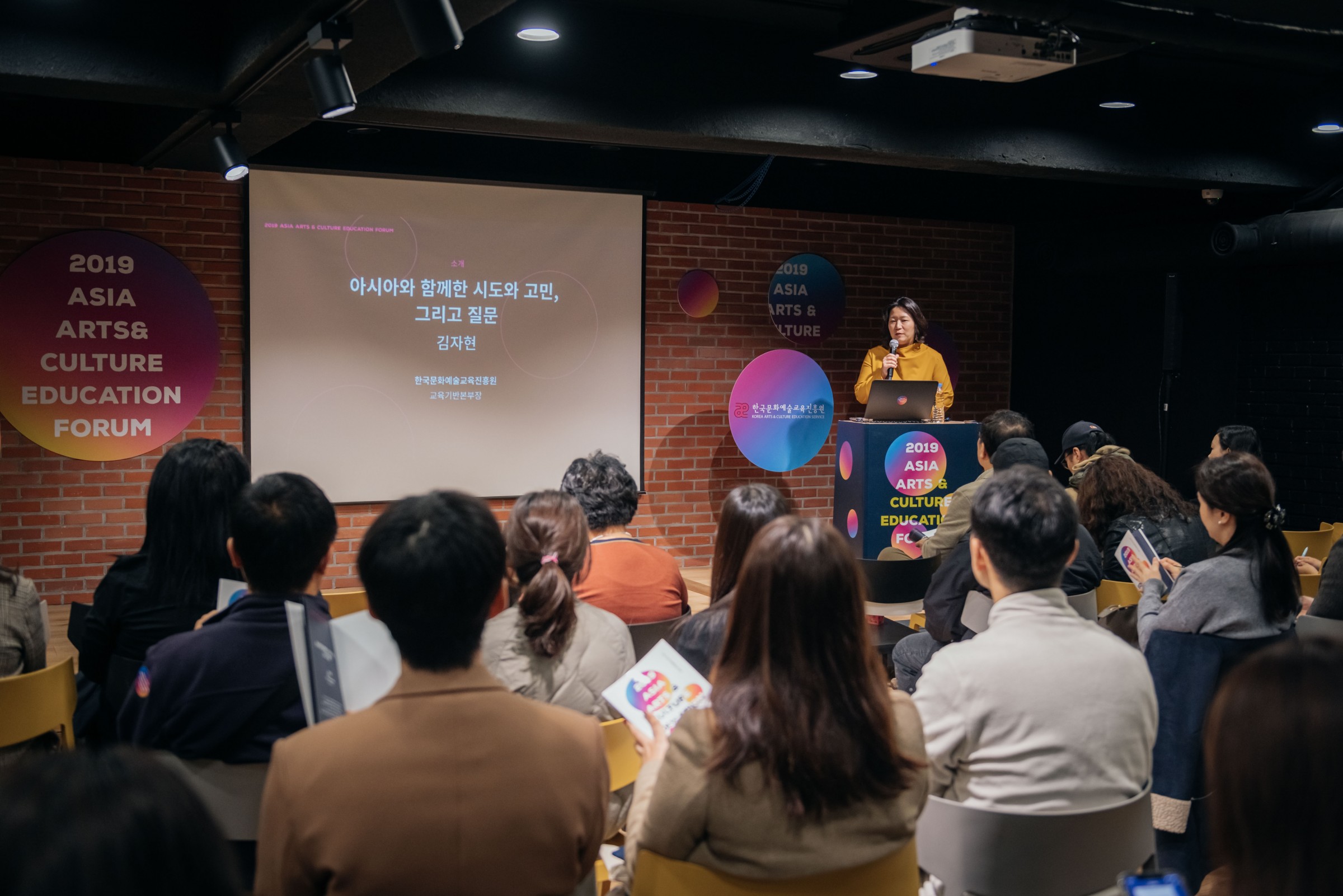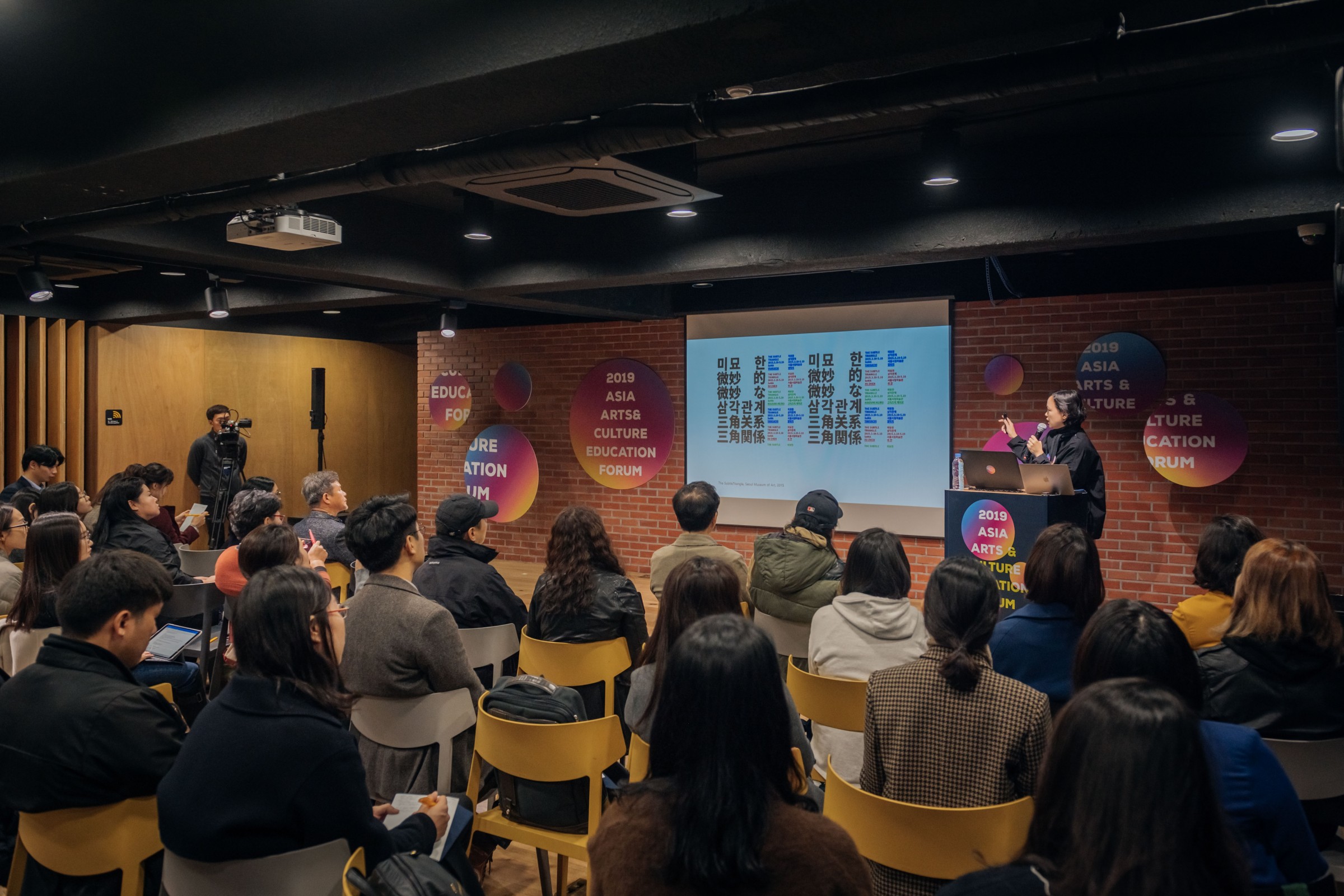KACES Newsletter Vol.12
2019
December 16
December 16
© 2019 KACES
FOCUS ARTICLES
Creating Arts and Culture Education through Social Practice of Arts: Finding the Changing Trends of Arts and Culture Education in Asia

The Korea Arts & Culture Education Service (KACES) hosted three rounds of forums to discuss field cases, discourse and policy exploration regarding Asia’s social engagement of arts and culture education, with the aim of eliciting more systematized questions and concerns on arts and culture education in Asia.
The effort began with exploring examples of socially engaged arts in regions in Asia. The first forum “What’ in Asia - arts, community, and education” was held on September 27th, where artists from multiple regions in Asia presented cases on how social issues in the regions are approached through artworks. The forum was held simultaneously with the “Gwacheon Festival,” a traditional local arts festival that engages local residents. A Korean participant, Lee Hanjin, gave a presentation on a visual archive of apartment buildings in Gwacheon that will soon go through re-development and disappear. Another Korean participant Lee Chulsung, a director of theater and performance company presented the case of his performance "Massagers" and shared its effect on various commnuties around the world. Joanna Chan from Macao introduced an arts and education program for senior communities to enhance the quality of life for the elderly. Divya Bahtia, an art director from India shared his experience of creating plays with citizens in Mumbai, a city stricken with poverty and unemployment. Lastly, Soul Signature, a Singaporian dance collective shared the case of promoting cultural diversity and inclusiveness through dance performance.
On October 10th, the second forum “Socially Engaged Art Practice and Its Value in Art Education,” focused on what kind of educational value can Asia’s socially engaged arts produce, was held in collaboration with the Performing Arts Market in Seoul(PAMS), an event that discusses social practice of performance arts and interdisciplinary arts. Three artists currently working on socially engaged arts projects in Asia were invited. Lee Jinyup, The director of a Korean theatrical company ‘Elephants Laugh’ explained that his art project is originally not focused on education, however that it does create educational value since it allows him to diversify his views on the society. Yoyo Kung, the director of art and performance company 'Prototype Paradise' from Taiwan pointed out that artworks can definitely offer educational value as participants get to learn together on a platform that can be shared with others. Giovanni Trono, an Italian director of theater company 'TeatrInGestAzine', also agreed that learning together and ceaselessly asking questions help us grow, which indeed provides educational opportunities.

The last forum “Asia Arts and Culture Education Forum: Contemporary Asia/Social Practice of Arts/Educational Value”, held on November 12th, served as a venue for re-visiting Asia as we know it from the perspective of socially engaged arts and exploring educational value in order to discover the overall connection among Asia, socially engaged arts and arts education.
The three presenters who conducted research on Asian arts and culture education with the KACES introduced new perspectives from which we can observe socially engaged arts and arts and culture education within regions in Asia. Curator Leeji Hong dismantled our traditional views on education and history and proposed a new way of examining Asia with keywords that were once omitted such as ‘stranger’ and ‘uncertainty.’ Seonghyo Ryu, Director of Creative Plan B, shared multiple cases to show that arts and culture education provides motivation for and triggers the socially vulnerable to change perception, while encouraging communities to seek education for all members. Producer Seokkyu Choi of Asia Now explored Asia’s socially engaged arts from the perspective of inclusiveness and diversity, explaining that “arts education” now needs to be re-defined as “creative learning” where everyone learns together.
The three presenters who conducted research on Asian arts and culture education with the KACES introduced new perspectives from which we can observe socially engaged arts and arts and culture education within regions in Asia. Curator Leeji Hong dismantled our traditional views on education and history and proposed a new way of examining Asia with keywords that were once omitted such as ‘stranger’ and ‘uncertainty.’ Seonghyo Ryu, Director of Creative Plan B, shared multiple cases to show that arts and culture education provides motivation for and triggers the socially vulnerable to change perception, while encouraging communities to seek education for all members. Producer Seokkyu Choi of Asia Now explored Asia’s socially engaged arts from the perspective of inclusiveness and diversity, explaining that “arts education” now needs to be re-defined as “creative learning” where everyone learns together.

In discussions that followed, participants shared their opinions to connect socially engaged arts with arts and culture education in an Asian context. They voiced that arts in Asia needs new perceptions and that solidarity is needed to make sure they are not objectified when we consider Asia. The participants discussed social participation of arts and explained that arts allow new perspectives to enter the society when we work with social minorities who are underrepresented within social ideology. Some argued that, along with these ethical characteristics of arts, socially engaged arts must always be capable of making diverse and extensive attempts as arts. Lastly, participants also discussed on the point where socially engaged arts and arts education overlap, expressing their thoughts on creative methodologies, questioning and taking fresh views on the traditional elements of arts, practicing within detailed relationships and situations, as well as how not to be confined to standards.
© 2019 KACES